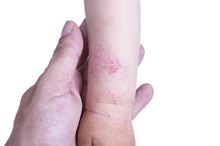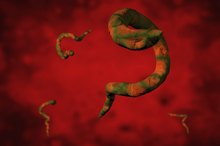Signs & Symptoms of Human Skin Mites
Just the thought of a human skin mite infection can make your skin crawl. Human skin mites are a type of arachnid called sarcoptes scabiei, more commonly known as scabies. They burrow just under the surface of the skin to lay their eggs. Both adults and children can be infected with scabies, and it is highly contagious.
Allergic Reactions
Itching is usually the first sign of a scabies infection. This is caused by an allergic reaction to the waste products left by the parasites and by the parasites themselves burrowing into the skin. Itching from a scabies infection tends to be worse at night and at the points of infection.
- Itching is usually the first sign of a scabies infection.
- Itching from a scabies infection tends to be worse at night and at the points of infection.
Rashes
How to Tell If a Human Has Ear Mites
Learn More
A rash on the skin at the site of infection or on other parts of the body is another symptom of skin mites. The rash can appear as red, raised bumps or can look like blisters or pimples. In adults, the most common rash locations are at the elbows, knees or genital area. In children, they can also appear on the face, palms or soles of the feet.
- A rash on the skin at the site of infection or on other parts of the body is another symptom of skin mites.
- In adults, the most common rash locations are at the elbows, knees or genital area.
Sores
Sores are a secondary symptom of a scabies infection and are usually caused by scratching the skin mite rash. Scratching opens up the blisters or pimple-like bumps on the skin, and these areas become infected. That creates an open sore or a sore that has a crusty appearance. Some crusted sores can also indicate a high concentration of skin mites under that sore.
- Sores are a secondary symptom of a scabies infection and are usually caused by scratching the skin mite rash.
- Some crusted sores can also indicate a high concentration of skin mites under that sore.
Mite Activity
What Causes Itchy Skin in Children?
Learn More
Skin mites are very small, and they cannot be seen with the naked eye. However, female skin mites burrow just under the skin's surface to lay eggs. This can sometimes be seen on the surface of the skin as a very thin line. These lines can be difficult to see, but they can be used to confirm that a rash or itchiness is being caused by a scabies infection.
- Skin mites are very small, and they cannot be seen with the naked eye.
- These lines can be difficult to see, but they can be used to confirm that a rash or itchiness is being caused by a scabies infection.
Warning
Scabies infections are highly contagious. They can be passed along through direct contact with someone infected with scabies. They can also be transmitted by sharing bedding or clothing with an infected person. It can take up to two months for a person infected with scabies to show signs of infection. It's usually recommended that all household members or sexual partners be treated at the same time to prevent reinfection.
- Scabies infections are highly contagious.
- It's usually recommended that all household members or sexual partners be treated at the same time to prevent reinfection.
Related Articles
References
- Micali G, Lacarrubba F, Verzì AE, Chosidow O, Schwartz RA. Scabies: Advances in Noninvasive Diagnosis. PLoS Negl Trop Dis. 2016;10(6):e0004691. doi:10.1371/journal.pntd.0004691
- Chandler DJ, Fuller LC. A Review of Scabies: An Infestation More than Skin Deep. Dermatology (Basel). 2019;235(2):79-90. doi:10.1159/000495290
- Su WJ, Fang S, Chen AJ, Shan K. A case of crusted scabies combined with bullous scabies. Exp Ther Med. 2015;10(4):1533-1535. doi:10.3892/etm.2015.2668
- Crusted scabies. Genetic and Rare Diseases Information Center. Published June 17, 2019.
- Mccarthy JS, Kemp DJ, Walton SF, Currie BJ. Scabies: more than just an irritation. Postgrad Med J. 2004;80(945):382-7. doi:10.1136/pgmj.2003.014563
- Centers for Disease Control and Prevention (CDC). "Scabies—Resource for Health Professionals." Atlanta, Georgia; updated March 21, 2017.
- Stiff KM, Cohen PR. Scabies Surrepticius: Scabies Masquerading as Pityriasis Rosea. Cureus. 2017 Dec 19;9(12):e1961. doi: 10.7759/cureus.1961.
Writer Bio
Sophie Stillwell has been writing professionally since 1992. She is published in "The Gorham Times" newspaper, "Private Colleges & Universities" magazine, on eHow and in several other publications. She has experience working as a paralegal, antiques dealer and neurobehavioral coach. Her writing topics frequently include frugal living, pets and health. Stillwell holds a Bachelor of Arts in English from the University of Southern Maine.









